Berlin is a city that my partner and I have wanted to visit for years. In April 2025, we finally made it happen and spent five nights there. I had done a lot of research and read that Berlin is generally wheelchair accessible, with many other wheelchair users saying how wheelchair accessible Berlin is. So I had high hopes and was excited to see if the city lived up to the hype.
Unfortunately, I ended up feeling pretty disappointed. As a power wheelchair user, I found it super tough to get around the city, which really affected how much we enjoyed our trip. Because of this, I don’t think I’d consider returning to Berlin anytime soon—unless I have an all-terrain wheelchair. But there’s more information on that later in the post.
So, if you are planning a trip of your own, read on for more information on where we stayed and the wheelchair accessible things to do in Berlin that we managed to tick off our list. But also the accessibility challenges we faced.
I also want to emphasise that I use my website to share my own lived experiences as a wheelchair user with Muscular Dystrophy. I don’t speak for all disabled people, and what works for me, may not work for you and vice versa. However, if you are planning a trip to Berlin, I hope this blog post gives you some useful information!

This Wheelchair Accessible Travel Guide to Berlin contains:
- Wheelchair Accessibility Challenges in Berlin
- A brief review of the wheelchair accessible hotel in Berlin where we stayed for five nights
- 5-day itinerary of things to see and do in Berlin as a wheelchair user
Wheelchair Accessibility Challenges in Berlin
Before I go any further, I thought it would be best to mention what challenges I faced in Berlin as a wheelchair user.
1. Footpath accessibility
Obviously, I knew from the get-go that Berlin is an old city steeped in history and that some areas would have cobblestones, which could make it difficult for me to get around. I also anticipated that some attractions might not be accessible. However, I didn’t expect to struggle as much as I did while trying to navigate the city.
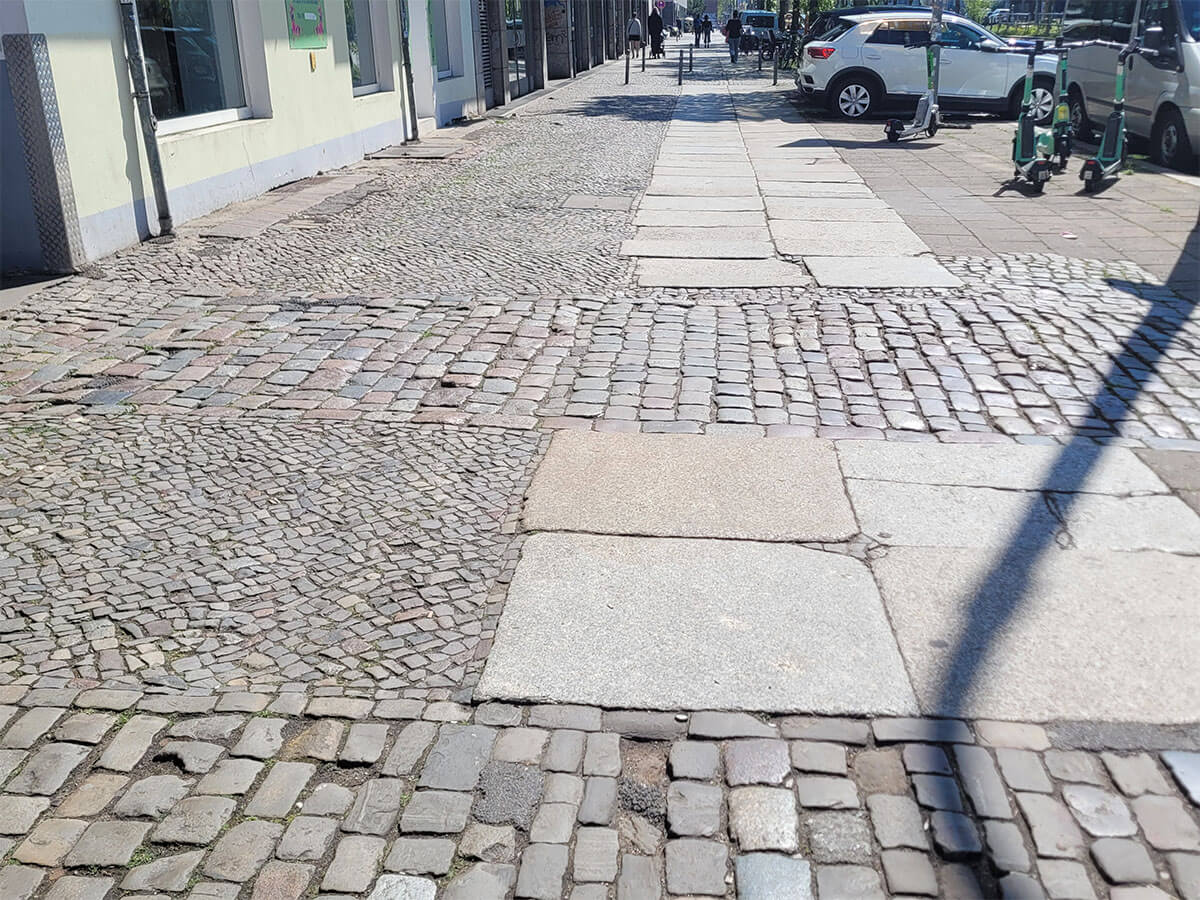

The main reason was the condition of the footpaths, which were in extremely poor shape. They were uneven, bumpy, sloped and broken, making it hard to drive across them. Even the square slabs had wide, deep gaps between them, causing my wheelchair to bang down onto each slab. This forced me to drive very slowly, and it was both painful and uncomfortable.
Throughout our five-day stay, I constantly had to drive slowly, watching out for obstacles, while dealing with the constant banging and rattling of my wheelchair. This was especially challenging since I lack trunk control, making it difficult to stay upright and supported on the bumps and uneven ground. It was exhausting and uncomfortable.
Although I typically enjoy exploring a city by wandering around, this experience was far from enjoyable. Honestly, I found it to be hard work, not what a holiday should be like. I’m surprised my wheelchair was still in one piece after the battering it took.
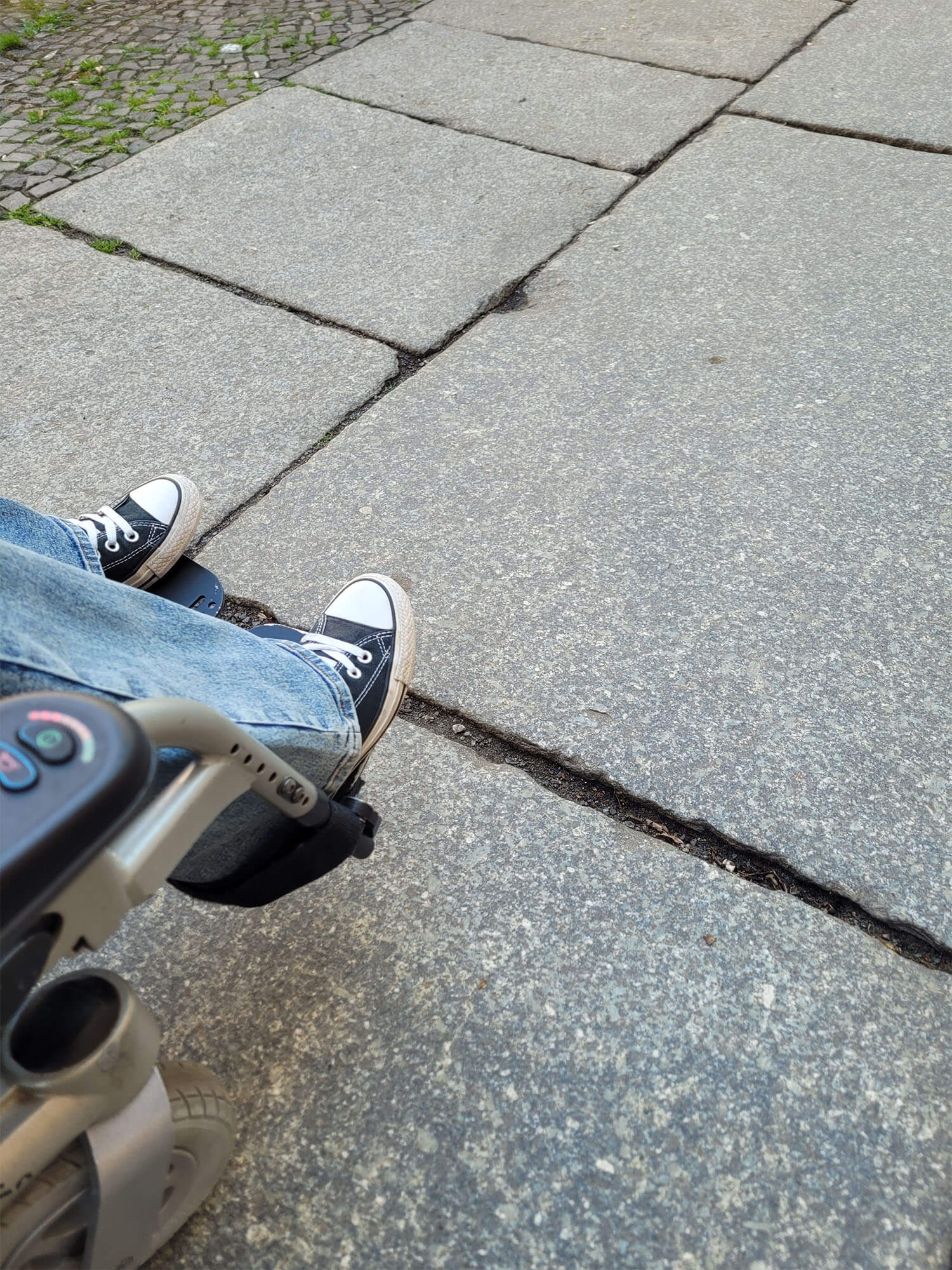
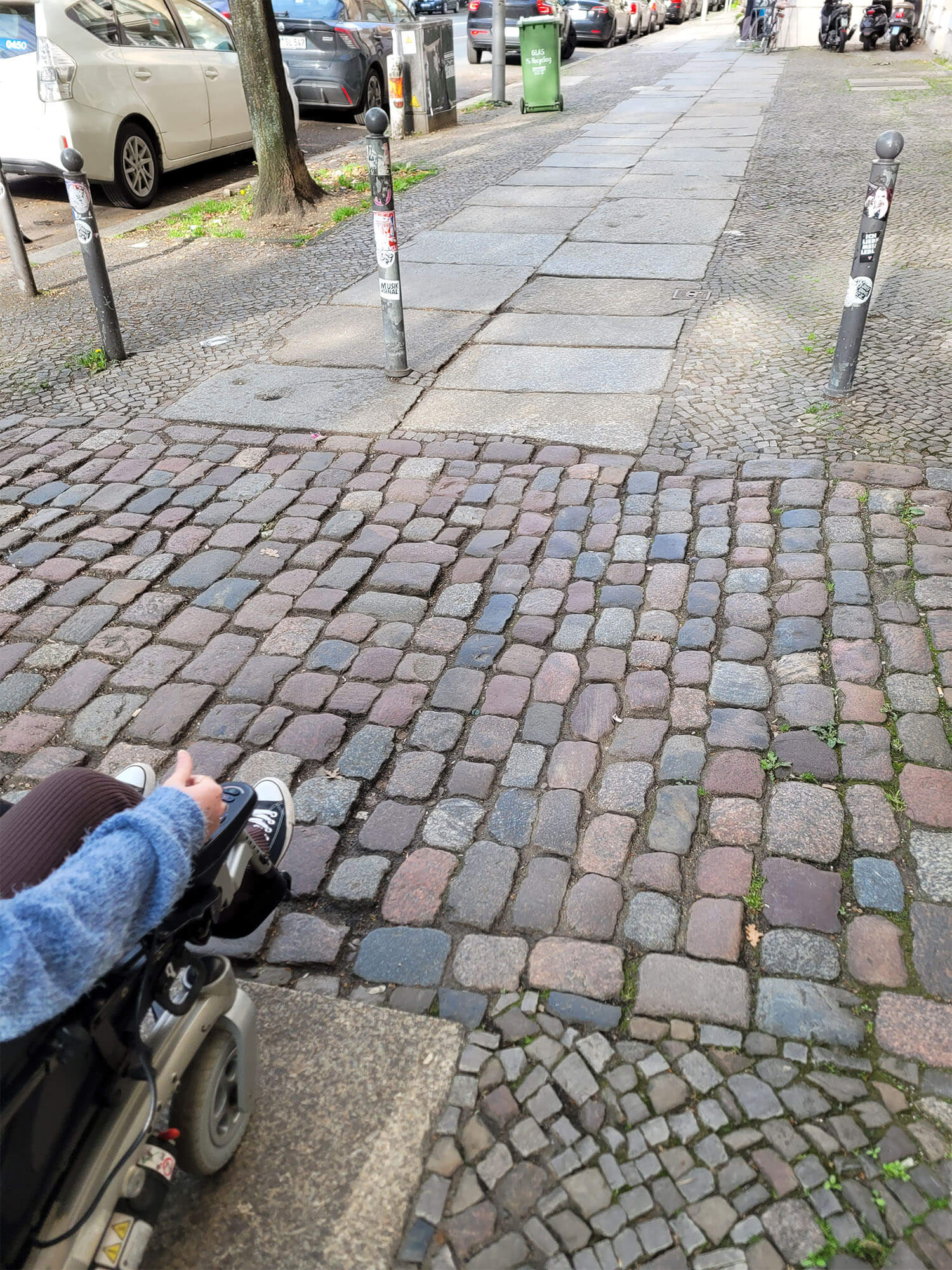
I only saw a few other wheelchair users in Berlin, and the ones I did see looked like locals. What I found interesting was that they were wheeling along the roads rather than the paths. This must be due to the roads being less bumpy, making it easier to get around. However, I wouldn’t recommend this, as being on the road with traffic can be much more dangerous.

2. Kerb height
The kerbs were also a challenge. Although some sections were lowered, most of the kerbs were still one to two inches high, making it difficult to navigate them repeatedly. Due to my lack of trunk control, I needed my partner to hold my shoulders to prevent me from falling forward. Sometimes, my wheelchair just wasn’t able to get up the kerb without a little push from my partner.
3. Inaccessible Restaurants and shops
Many restaurants, cafes, and shops had steps leading up to them. Even when the restaurant had outdoor seating, it was still inaccessible because it was on a raised decking area.
Where to stay in Berlin? The Circus Hotel
We stayed for five nights in a wheelchair accessible hotel room at The Circus Hotel, a boutique hotel located on Rosenthaler Platz in the vibrant heart of Berlin Mitte.
The room was cosy and spacious, featuring an incredibly comfortable bed. There was enough clearance underneath the bed to accommodate a mobile hoist. The ensuite wet room was also well-sized, equipped with a roll-in shower, a wall-mounted shower seat, grab bars, and a roll-under sink.
Read my full review of my stay in a wheelchair accessible room at The Circus Hotel below.
A Wheelchair Accessible Travel Guide to Berlin, Germany
Day 1 in Berlin: City Centre
We decided that a good place to start our first day in Berlin would be the city centre. We were able to get our bearings and a feel for the city while managing to visit some of Berlin’s top attractions.
We explored the city by walking/wheeling, but another way to familiarise yourself with Berlin is to go on a hop-on/hop-off sightseeing bus tour. This could be a good option if you also struggle with the bumpy, uneven paths.
Here’s everything we did on day 1 in Berlin:
Alexanderplatz
Alexanderplatz is considered the heart of Berlin and is one of the city’s best-known public squares. It is also home to one of Berlin’s most famous landmarks—the TV Tower.
Alexanderplatz is about a fifteen-minute walk from the Circus Hotel, where we were staying. Since it was Good Friday, many shops and businesses were closed, but the square was still bustling with people coming and going, as it serves as a major transportation hub.
While Alexanderplatz isn’t the most picturesque area and appears quite rundown, it is historically significant as it was the centre of East Berlin during the Soviet occupation in the Cold War era.
You may even recognise Alexanderplatz from being a movie location for “The Bourne Supremacy,” where Bourne meets an agent under the world clock.
TV Tower
Wherever you are in Berlin, you can easily spot the TV Tower rising above the buildings. It is the most prominent feature of the city’s skyline and is considered a must-see when visiting Alexanderplatz.
Although the TV Tower is an attraction that visitors can pay to ascend for a view of Berlin, it is not wheelchair accessible. Personally, I didn’t mind this, as I had read that the view from the top is not worth the cost, and there are cheaper viewpoints around the city.
The weather on our first day in Berlin was very cold and cloudy, so the TV Tower was hidden behind the clouds. However, over our five days in the city, we experienced almost every season, allowing us to finally see it clearly against blue skies.


World Clock (Weltzeituhr)
The World Clock at Alexanderplatz represents the 24 time zones of the world. It was restored after the fall of the Berlin Wall, during which some of the cities listed were corrected due to being assigned to the wrong time zones.
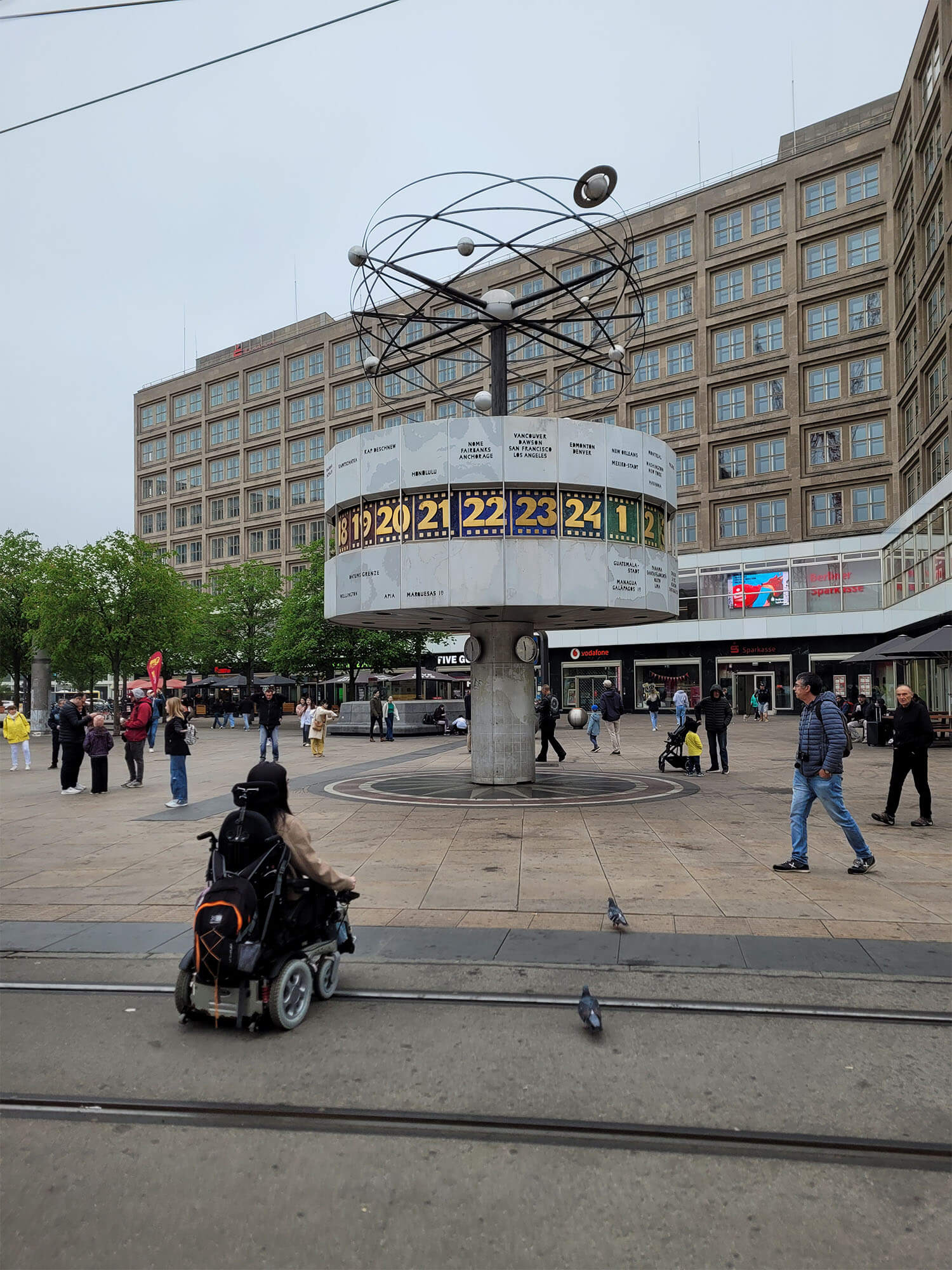
Neptune Fountain (Neptunbrunnen)
There are two fountains at Alexanderplatz, and the Neptune Fountain is definitely the more attractive one. It sits between St. Mary’s Church and the Red Town Hall and features the Roman god Neptune at the centre, surrounded by four women representing the four main rivers of Prussia at the time the fountain was built.
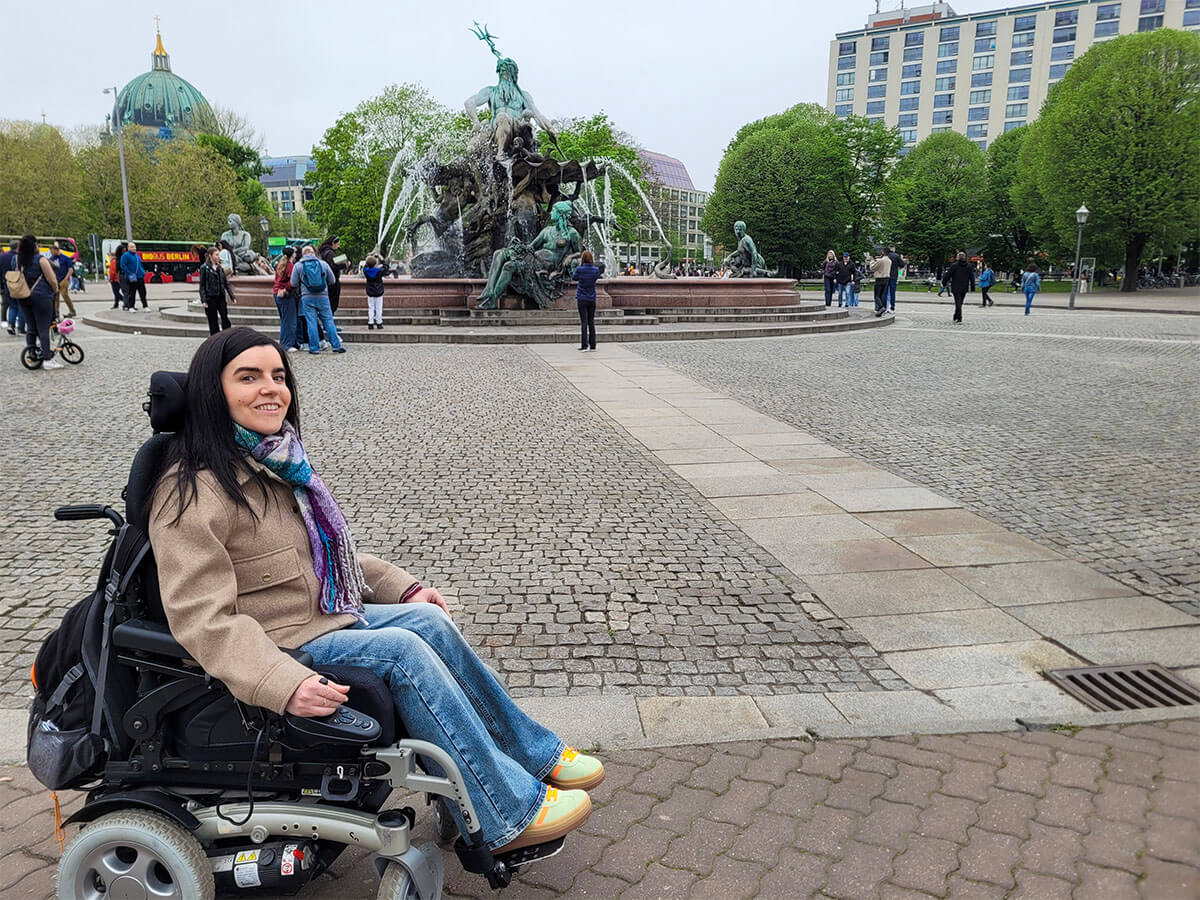
To get close to the fountain, you will need to bump down a kerb if your wheelchair can manage it. Although there are cobblestones surrounding the fountain, there are also paved pathways leading to each female sculpture.
During the Christmas market season, the base of the fountain is transformed into an ice rink, which I can imagine looks beautiful.
Museum Island (Museumsinsel)
Museum Island is a UNESCO World Heritage site home to five world-renowned museums. It’s a short walk from Alexanderplatz, making it our next stop of the day.
If you enjoy museums, you could easily spend the afternoon or even a full day on Museum Island!
However, if you only have a few days in Berlin, I recommend picking one museum and spending an hour or two inside. If museums aren’t your thing, that’s perfectly fine; you can still visit Museum Island to admire the stunning architecture. (More on Museum Island further down this post.)

Unfortunately, the weather during our visit was quite cold, and we were both very hungry, so we were eager to find a café or restaurant for lunch. The chilly weather really affected me, and I was struggling to drive my wheelchair at this point. We found it difficult to find somewhere to eat.
Since the Humboldt Forum was nearby, we decided to pop in, thinking there would likely be a café or restaurant inside.
Humboldt Forum
The Humboldt Forum is a free museum with a cultural centre and exhibition space. There is also a viewing terrace at the top of the building that costs three euros, which could be a good alternative to the TV Tower for enjoying views of Berlin.
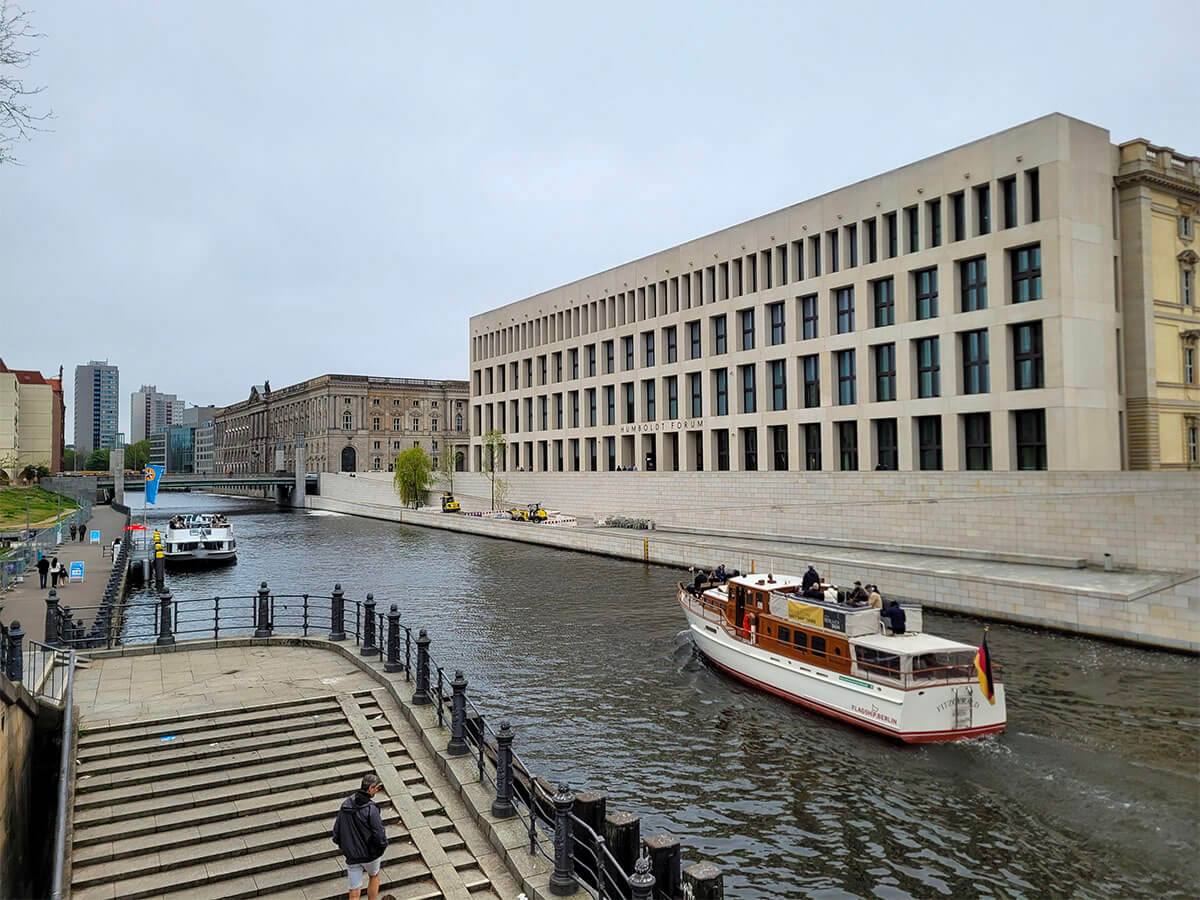
The Humboldt Forum was built between 2013 and 2020 on the site of the former Berlin Palace. We wandered through the Sculpture Hall, which features various sculptures and fragments from the Palace that span several centuries. It was warm inside the Sculpture Hall, so it was a welcome relief from the cold outside.




I’m not sure if it was due to being Good Friday, but many parts of the museum seemed to be closed. Even the restaurant was closed. Although there was a bistro available, it didn’t offer anything we could eat.
Berlin Cathedral (Berliner Dom)
The Berlin Cathedral is located across the street from the Humboldt Forum on Museum Island and is the largest church in Berlin. We didn’t go inside the cathedral; instead, we admired its impressive exterior.
Tours of the cathedral are available, with reduced admission for people with disabilities. However, the main entrance is not accessible. Wheelchair users must enter to the left of the main entrance, where you can press a call button and wait for assistance to enter through the gate and access a lift that takes you into the cathedral.

Unter den Linden
In pursuit of food and to stay on track for the rest of the day’s plans, we continued along the tourist route towards the Brandenburg Gate.
On our way, we walked along Unter den Linden, a wide boulevard lined with linden trees (hence the name) that runs from Museum Island to the Brandenburg Gate. The trees date back to the 1950s.
Unfortunately, we couldn’t find a suitable place to eat along the way. There weren’t many food options, and any we did see were either inaccessible (with steps), had outdoor tables and seating, but the tables were too small, and it was too cold to sit outside. Or there were food stalls that didn’t provide a place for me to lean while eating.
From this point, I developed a strange migraine feeling, and my eyes had blurred spots, so I couldn’t really see. Hence, I was wearing sunglasses when it was cloudy.
Brandenburg Gate
Our next stop was Berlin’s most famous landmark, the Brandenburg Gate. Once a dividing point between East and West Berlin during the Cold War, it has since become a symbol of peace and unity.
The gate is flanked by the Quadriga, a chariot drawn by four horses, representing victory and symbolising peace entering the city

Memorial to the Murdered Jews of Europe
After visiting Brandenburg Gate, we walked to the Memorial to the Murdered Jews of Europe, which is only a short distance away.
This memorial, also known as the Holocaust Memorial, serves as a reminder of the millions of Jews who lost their lives under the oppressive Nazi regime.

The memorial consists of 2,711 concrete blocks covering an area of 19,000 square meters. As you go deeper into the labyrinth of concrete slabs, the ground becomes uneven and dips, creating a feeling of confinement and suffocation. The memorial aims to evoke uncertainty and encourage contemplation.
I personally struggled getting around the memorial in my powerchair due to the steep and uneven ground. The awkward angles made it difficult for me to stay upright while driving, and combined with being so cold, my partner had to help me drive my wheelchair through the memorial.


There is a museum located underneath the memorial with lift access, but we weren’t able to get the staff’s attention to let us in the lift.
Back to our hotel
At this point in the day, we were hungry, having failed to find somewhere to eat. It seemed that every restaurant or cafe we tried to visit was either closed or inaccessible. I was also frozen, making it difficult for me to operate my wheelchair.
On top of that, the paths in Berlin were extremely uneven and bumpy, which left me feeling exhausted. So, we decided to head back to our hotel to rest and warm up.
Dinner at La Cantina
After resting in our hotel room, we went out for dinner. We found an Italian restaurant on Google Maps that was just around the corner from our hotel. The restaurant was called La Cantina, and we both really enjoyed our meals. I had a pasta dish, while Allan chose a pizza.
The restaurant wasn’t busy, and the table where we were seated felt quite spacious. The walls were lined with wine bottles and plants trailing from the ceiling, while part of the ceiling and windows resembled a glasshouse overlooking a courtyard, which I think is part of the Circus Hotel courtyard.


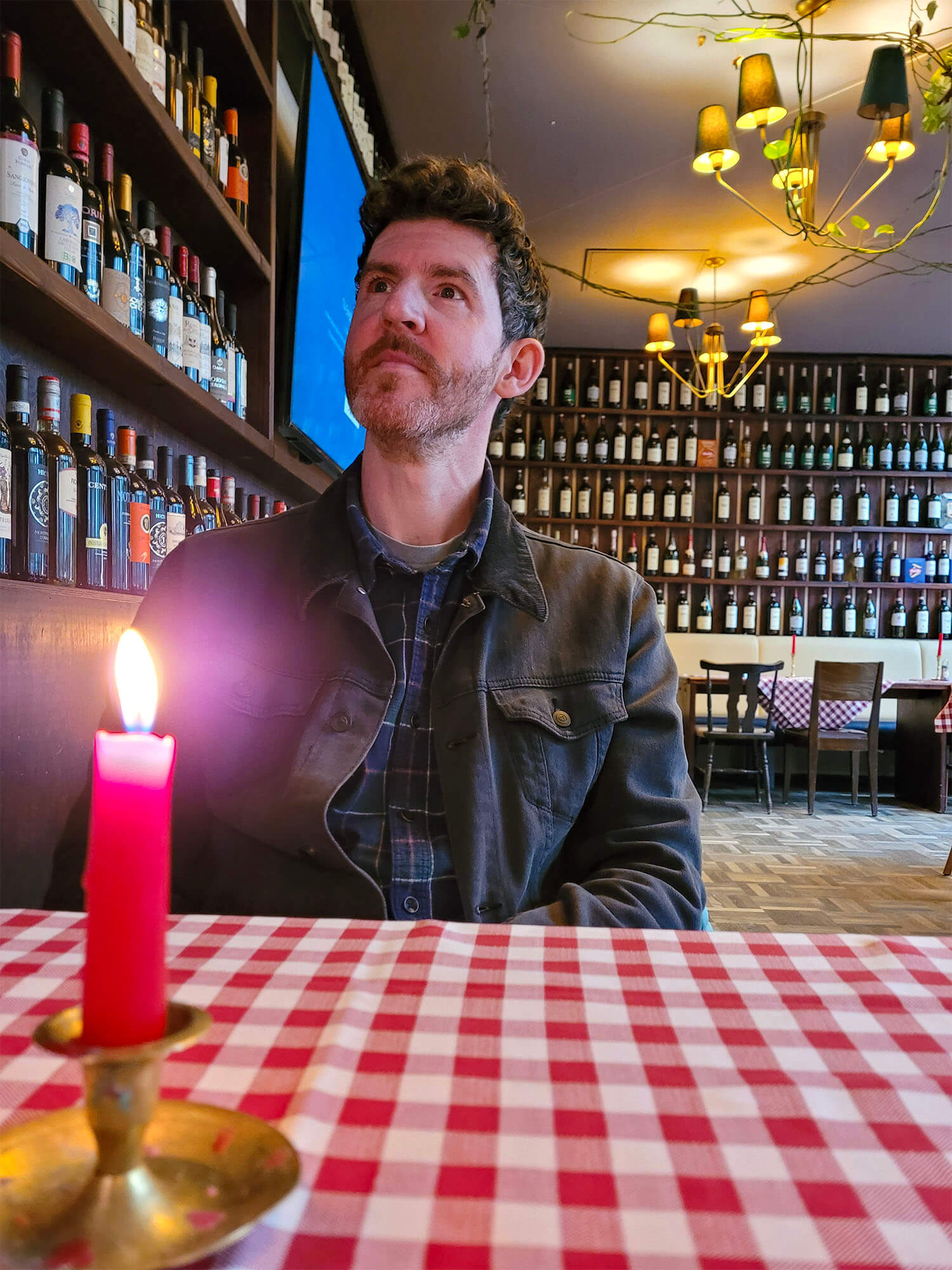
Day 2 in Berlin: Museum Island
Our original plans for day two in Berlin included visiting Charlottenburg Palace and Gardens, followed by a trip to Tiergarten Park. However, due to extremely cold and rainy weather, we decided to change our plans so that we were mainly indoors.
Since we didn’t manage to visit any of the museums at Museum Island the day before, we planned to spend most of the day exploring them. Or so we thought.
This wasn’t a good day. The weather, the uneven/bumpy paths and kerbs made it difficult for me to drive my wheelchair, plus access issues getting into the museums, all contributed to us feeling a bit low on this day. After a few hours, we retreated to our hotel.
Here’s everything we did on day 2 in Berlin:
Museum Island
By the time we arrived on Museum Island, we were soaked and frozen. There are cobblestones all around, so I found it difficult driving my wheelchair. Most of the museums also have steps at the entrance, so finding the wheelchair accessible entrance was a challenge, especially when I was struggling to cross the cobblestones. We didn’t want to have to double back on ourselves.

Altes Museum
To get out of the rain, we headed for the closest museum, the Altes Museum. We spotted a sign showing that the wheelchair accessible entrance was around the side. We found a door, but there was no clear signage that it was the accessible entrance, so we opened it anyway.
Inside, a man was sitting at a desk behind a glass screen. He told us to wait for someone to come and get us. Another man arrived, but he never spoke a word to us; he just looked right through us.
We followed him through a long, empty corridor that looked like a prison, then in a lift, and through a locked metal gate, into the museum.
He didn’t say anything to us, just walked away. He made us feel uncomfortable, like we were an inconvenience when all we wanted was to enter the museum like everyone else.


We approached another member of staff and asked where the cafe was. He pointed to the ticket office and told us we needed to buy a ticket before we could go into the cafe. We weren’t sure if we had misunderstood, but a few other people were asking the same question and getting turned away.
We were so cold, and I could barely move my hand to drive my wheelchair. We just wanted to sit down and have some lunch, and let me rest for a little while after the state of the paths. But the ticket queue was so long, and we weren’t in the best mood by this point, so we decided to leave the museum and go somewhere else.
We had to get the same unfriendly man to take us back into the lift and along the prison-like corridor. Again, he didn’t speak and looked angry. We didn’t like the customer service or the vibe of the Altes Museum at all. More so, we didn’t like the hassle of getting in and out of the museum as a wheelchair user. We felt like a huge inconvenience.
Alte Nationalgalerie
The Alte Nationalgalerie was close to the Altes Museum, so we decided to try there next. Again, there were cobblestones everywhere.

We found the accessible entrance around the back. Once inside, the museum staff unlocked a door to let us in, and then we took the lift up. We wanted to visit the cafe first, but it was an espresso bar and it was up a few steps, so we had to turn around and leave.
Again, the queue for tickets was huge, and we just wanted to get something to eat before touring around the museum. So we left.
Alexanderplatz
Our day wasn’t going as planned, so to escape the rain and cold, we decided to head back to the Alexanderplatz area. The day before, we had noticed a TK Maxx store that was closed due to Good Friday, but we hoped it would be open now that it was Saturday.
Fortunately, when we arrived, the store was open. We walked inside and headed towards the lift, only to find an “Out of Order” sign and a red barrier across the doors. Our streak of bad luck was continuing.

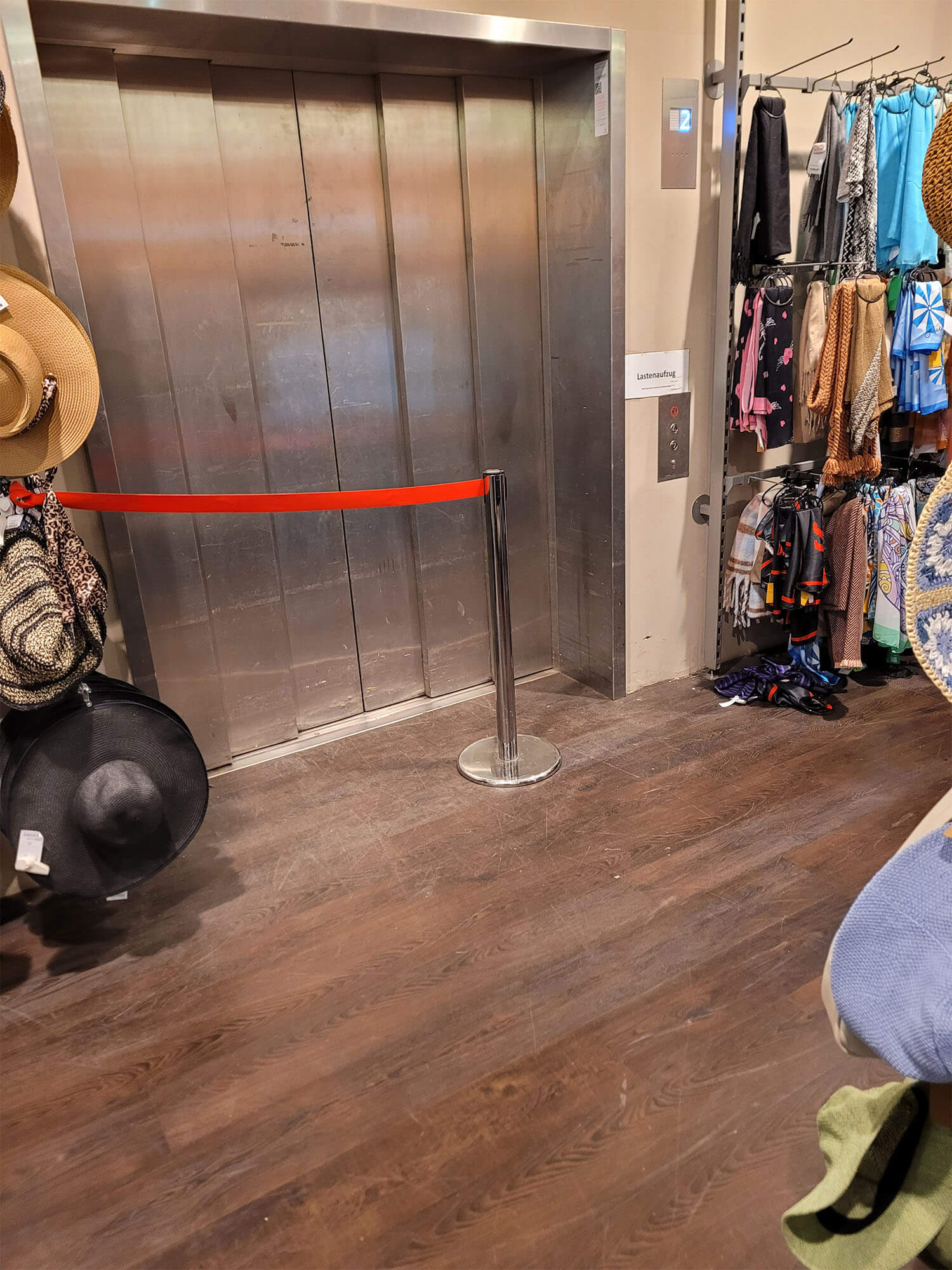
Back to our hotel
We wandered around the area a little longer before deciding to head back to the hotel. We loved going back to our hotel room. It felt like our little safe place after tiring days navigating the paths around Berlin.
After relaxing and decompressing in our hotel room, we ventured out to the supermarket for food and drinks.
On our way back to the hotel, we decided to get pizza from Fergy Detroit Deep Pan. It was incredible. Even better, the pizza place was directly below our hotel, so we enjoyed eating it in our room.
Day 3 in Berlin: East Berlin
After another restful sleep, we woke up feeling good and to sunshine. The beautiful spring weather had returned. We were feeling good and felt positive about our third day in Berlin.
Here’s everything we did on day 3 in Berlin:
Breakfast at the hotel
We enjoyed a lovely breakfast of pancakes and oyster mushrooms with beetroot waffles at Lost My Voice situated on the ground floor of the hotel.

RÄW Gelände Vintage & Flea Market
I had read somewhere that no weekend in Berlin is complete without hunting for treasures at the local flea market! Flea markets are a huge part of Berlin’s culture, so what better way to spend our Sunday morning than a visit to some of Berlin’s best flea markets?
Apparently, RÄW Gelände vintage and flea market is where to go if you want to get the best vintage finds sold by locals. The main entrance on Warschauerstr is not accessible, so we went to the east part of the area on Revalerstr. There is an entrance that is a gradual slope into RÄW Gelände.
As soon as we arrived, we noticed the ground was uneven in some parts with cracks and huge holes in the concrete. This made it quite difficult to navigate around, especially with the crowds as well. The market was dirty, and there wasn’t anything of interest to us. We felt the market was a disappointment and wouldn’t recommend going.


Boxhagenerplatz Market
Boxhagenerplatz Market was another flea market that came highly recommended to us, so we decided to check it out. It was only a ten minutes walk from RÄW Gelände, and we hoped it would be better.
Boxhagenerplatz market in Friedrichshain is described as having a great mix of local designers, street food, and fresh produce, including fruits, vegetables, and honey. The stands are arranged around the square and mainly sell second-hand clothing, jewellery, and household items.
We were on the lookout for small framed artwork that we could fit in our suitcase, but unfortunately, nothing caught our eye. Like many markets, it was quite busy, which made it difficult at times to stop and browse the items.
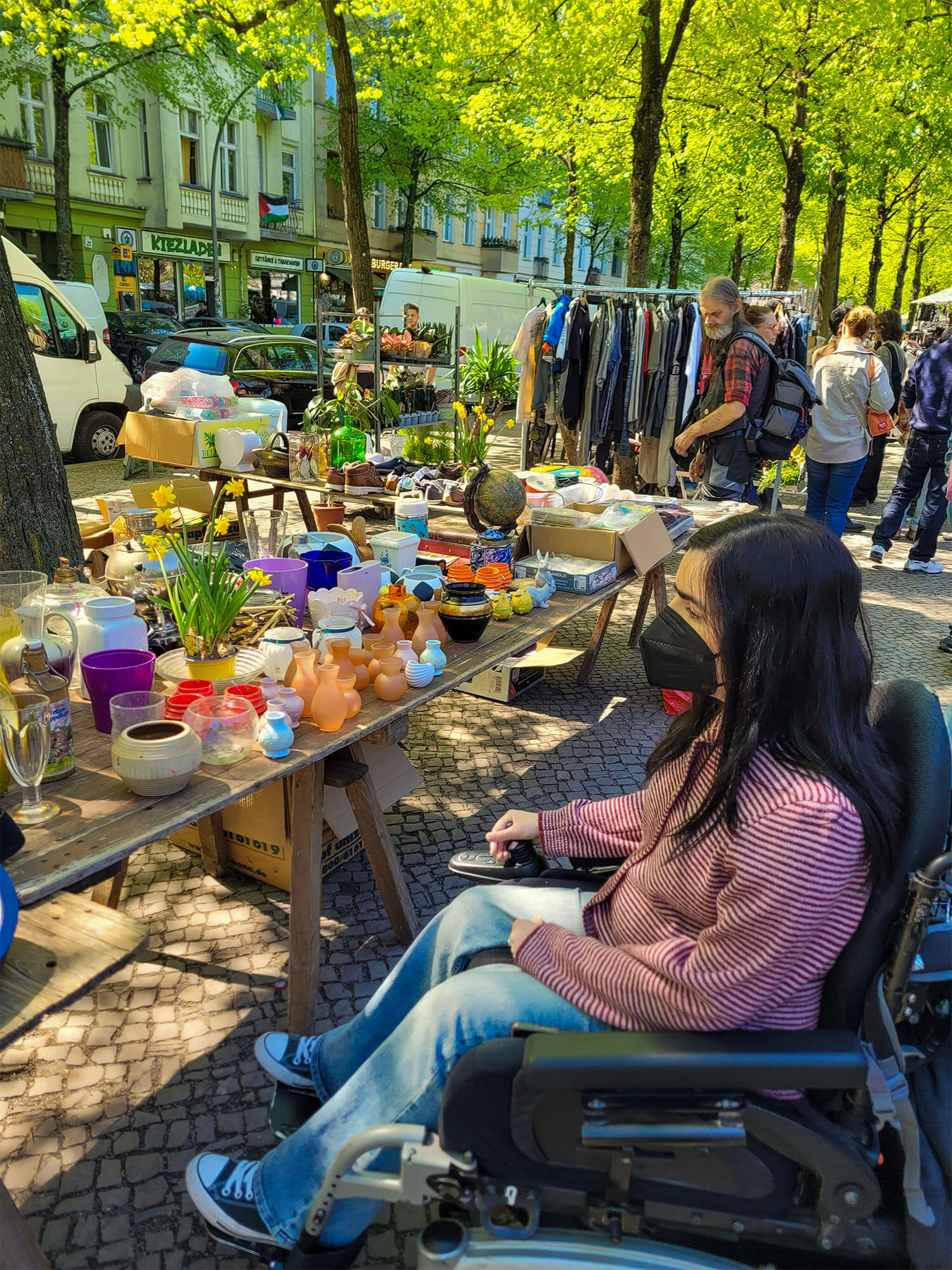

East Side Gallery
After visiting the market, we headed toward the Oberbaum Bridge (Oberbaumbrücke) to see the East Side Gallery.
The East Side Gallery is one of Berlin’s most famous attractions. It’s the largest remaining piece of the Berlin Wall and the largest open-air art gallery in the world, featuring 1.3 kilometres of large-scale murals. The wall is constantly updated by talented street artists.


Along the way, we also discovered a lovely park with beautiful cherry blossom trees. It was a nice spot to escape the crowds.


Oberbaum Bridge (Oberbaumbrücke)
Once we had seen many of the murals, we went behind the wall to the park that runs between the wall and the Spree River. We got a nice view of the Oberbaum Bridge from here.
The Oberbaum Bridge is a double-deck bridge that crosses the Spree River, connecting the former East and West sides of Berlin. This bridge served as a popular crossing point for Westerners trying to enter East Berlin.
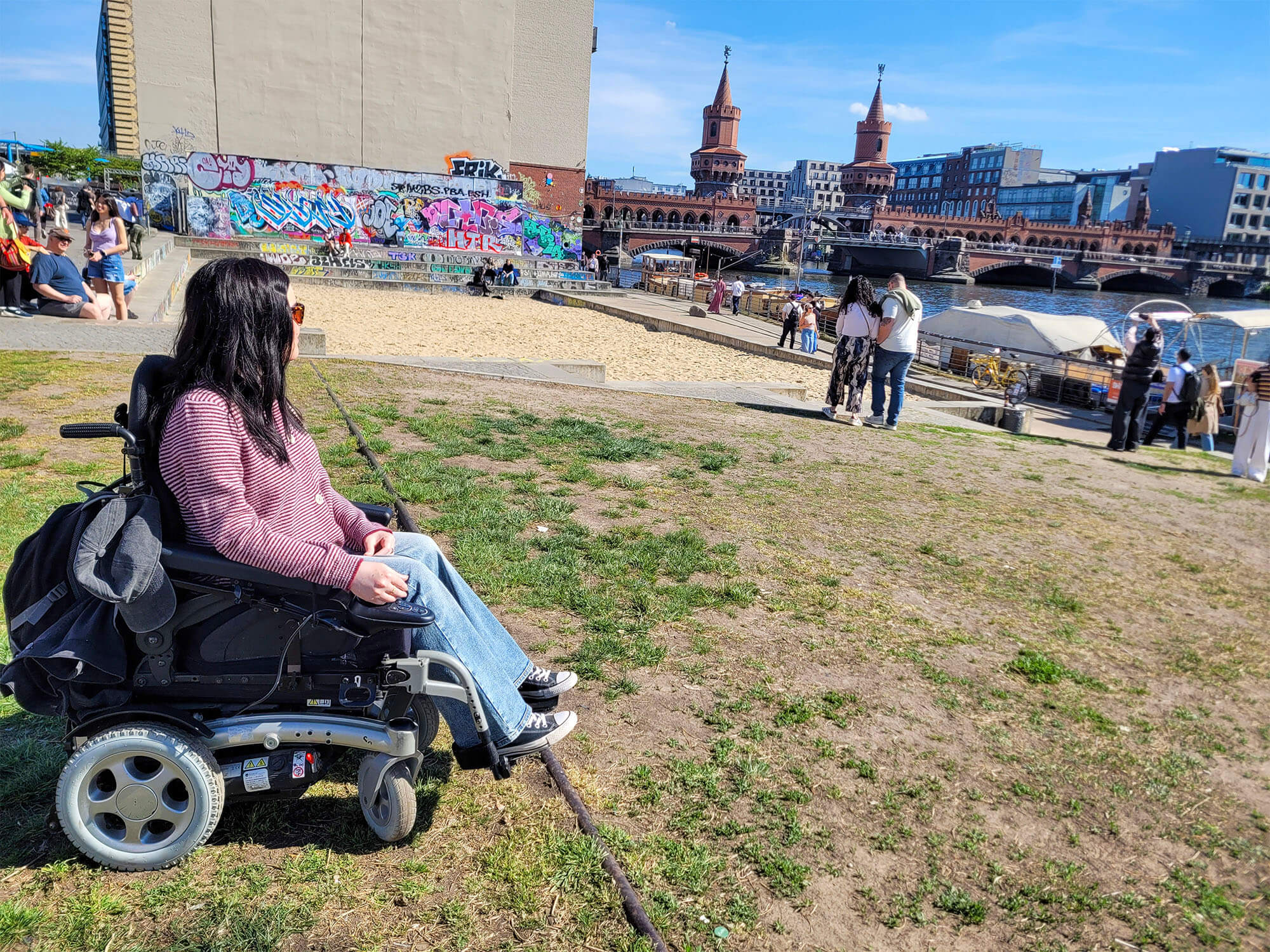
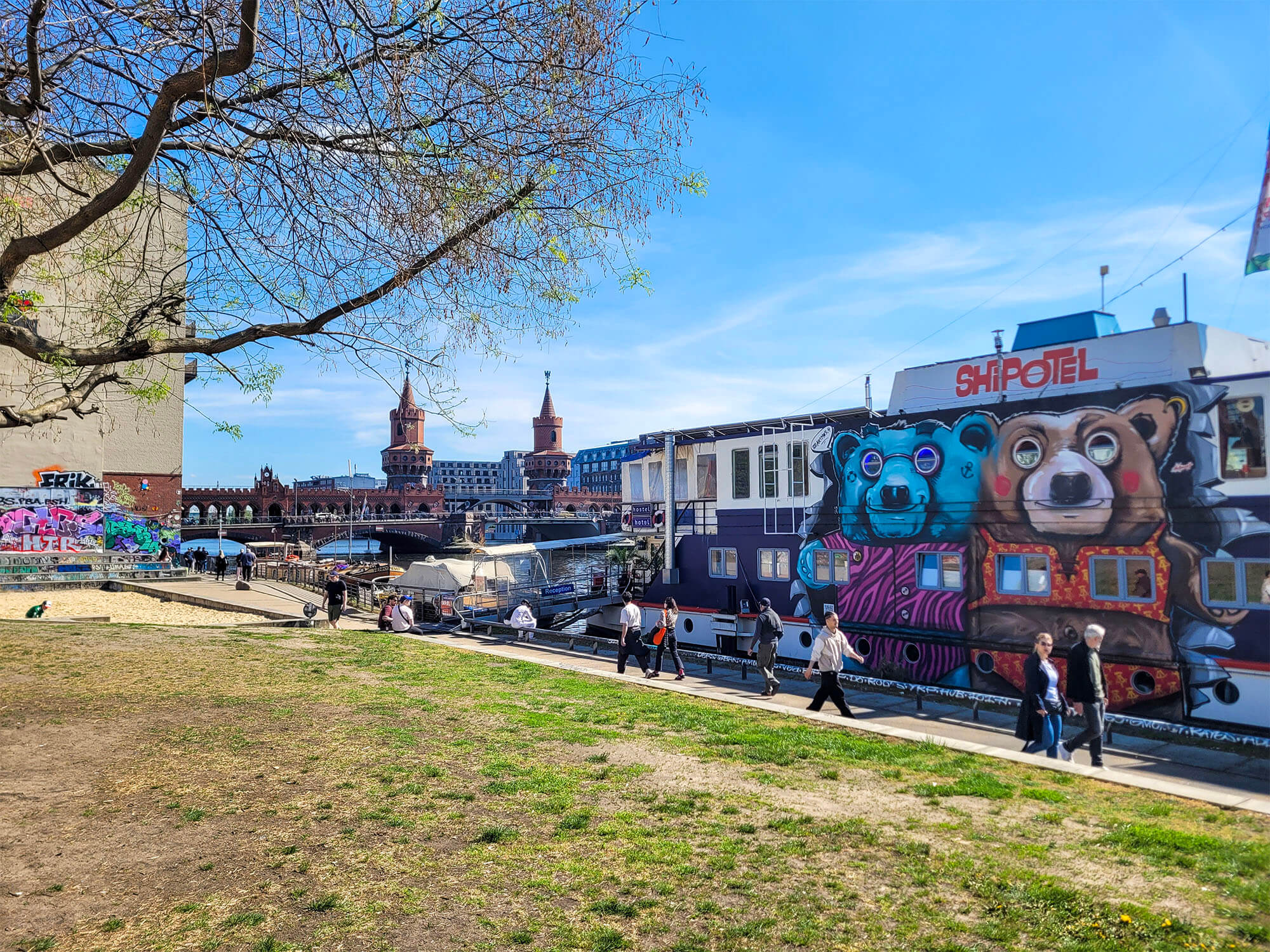
Dinner at ALEX Berlin am Alex
Once again, we struggled to find a suitable and accessible restaurant. Finally, we stumbled upon ALEX Berlin am Alex in Alexanderplatz, and it was fantastic. The interior was beautifully decorated, and we both enjoyed delicious meals and desserts. The portion sizes were large and very reasonably priced.
Before leaving the restaurant, we decided to pop to the toilet. As we turned the corner, we noticed an out-of-order sign on the accessible toilet. Remember what I was saying about our bad luck on this trip?



Day 4 in Berlin
We had planned to go to Berlin’s Botanic Garden, but since it was Easter Sunday and it was quite a distance from our hotel, we decided it would be best not to, as we weren’t sure if there would be fewer public transport services running.
Here’s everything we did on day 4 in Berlin:
Tiergarten
Tiergarten is Berlin’s largest park, featuring various gardens, ponds, statues, and memorials. Originally, the royal hunting grounds during imperial times, it was opened to the public in the 1830s.



We enjoyed a leisurely stroll through the park, stopping to see some sights, including the Soviet Memorial Tiergarten, which commemorates the Soviet soldiers who fell during the Second World War. We also visited the Beethoven-Haydn-Mozart Memorial located within the park.



The paths throughout Tiergarten were wheelchair accessible, and I didn’t have any issues getting around.

Potsdamer Platz & Sony Center
After exploring Tiergarten, we made our way to Potsdamer Platz, formerly known as Sony Center. I had read about this area and received recommendations to visit from someone we met at the airport. Unfortunately, what we found was quite different from what we had expected, and we were honestly disappointed.
Potsdamer Platz features a cinema, a museum, restaurants, and offices, but there wasn’t much happening during our visit. The former Sony Center is well-known for its dome-shaped roof, which lights up at night. You’re not missing much if you don’t see this, and I wouldn’t suggest going out of your way to visit.
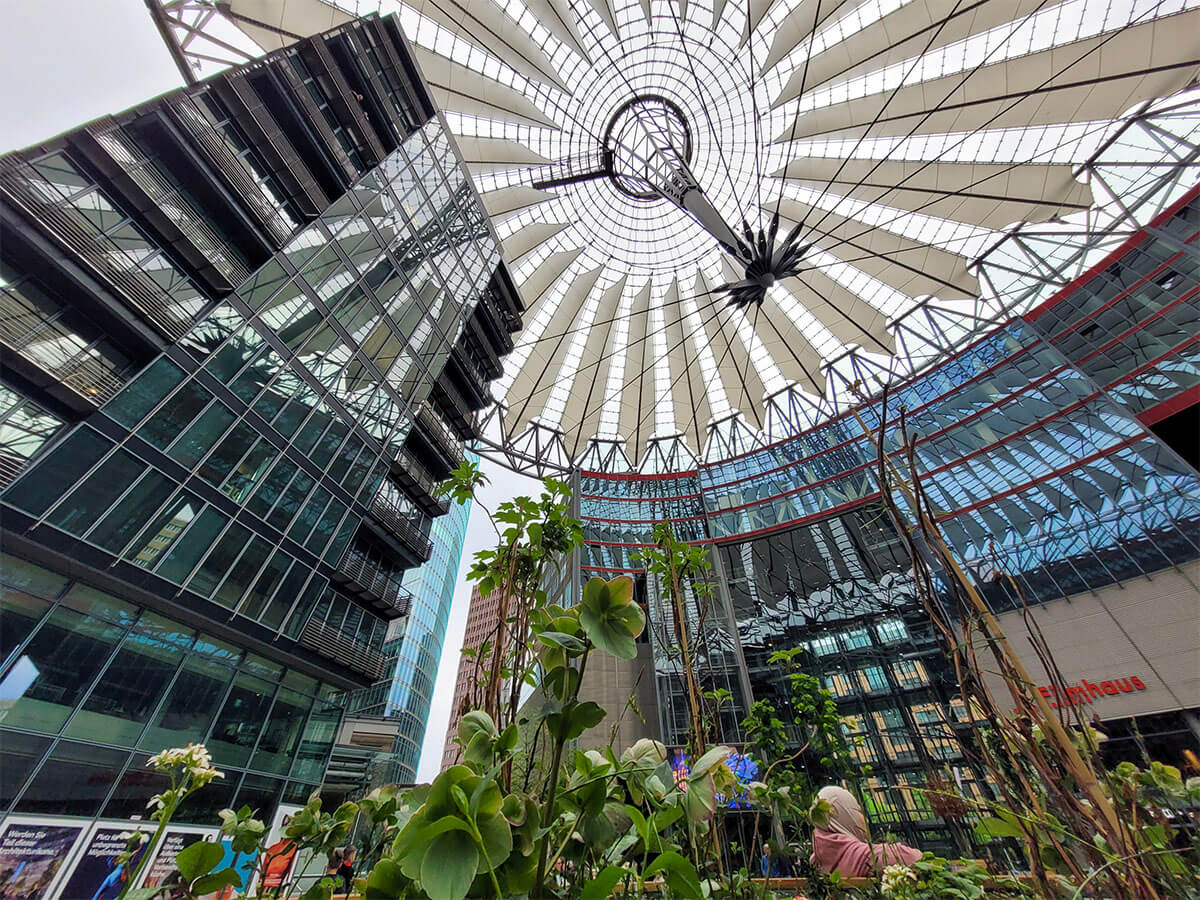
Day 5 in Berlin
Our fifth and final day in Berlin. The weather was pretty decent and we managed to have a delicious brunch, visit a few museums before heading to the airport for our flight home.
Here’s everything we did on day 5 in Berlin:
Brunch at FREA Bakery
Frea Bakery was recommended by our hotel, and I’m so glad we chose it for brunch. Our only regret is that we left it for our last day, as we would have loved to visit at least once more during our trip.
Frea Bakery is a café and brunch spot that serves delicious sourdough bread, sandwiches, pastries, and lunch dishes.
While we enjoyed the food, we were somewhat disappointed with the staff when we asked if there was a ramp to enter the café. Two staff members stared at each other blankly and replied no. Fortunately, a third staff member overheard us and pointed out the portable ramp leaning against the wall next to them.
The food was absolutely delicious, though!

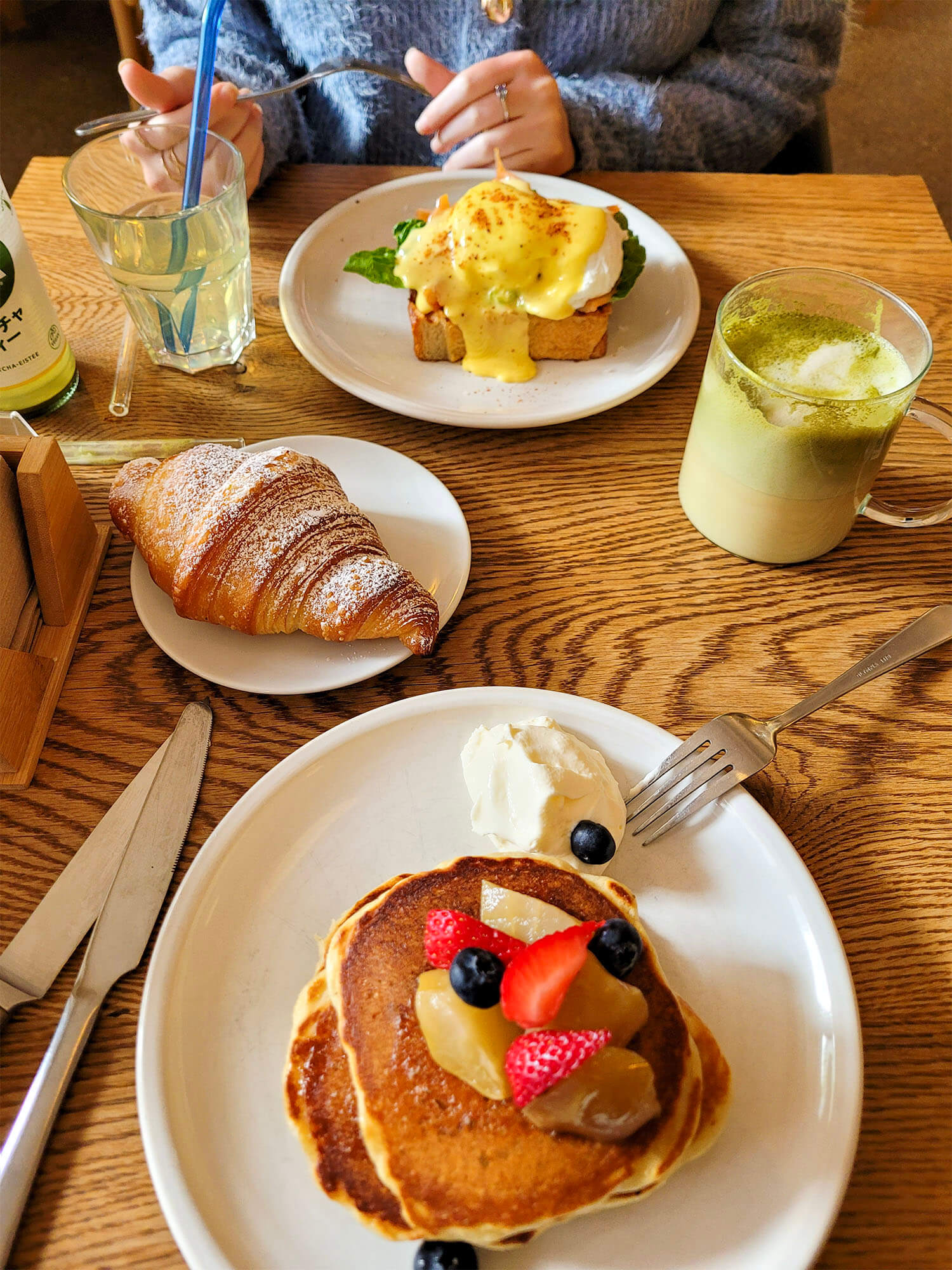

Hamburger Bahnhof
After brunch at Frea Bakery, we headed to Hamburger Bahnhof. This former train station, which once had trains departing for Hamburg, has been transformed into a modern gallery featuring contemporary art and rotating exhibitions.
The museum is wheelchair accessible with a ramp to the entrance. Disabled visitors receive a 50% discount on admission, but you must provide documentation proving your disability.
Even though my disability is very visible, they would not grant me the reduced admission fee. Carers and companions can enter for free, but once again, they would not allow Allan free admission because we didn’t have proof of my disability.
One of the lifts was out of service, so we weren’t able to visit every exhibition. Personally, we were quite underwhelmed by Hamburger Bahnhof and found it lacking anything of interest. I wouldn’t necessarily recommend visiting unless you are in the area and love contemporary art.
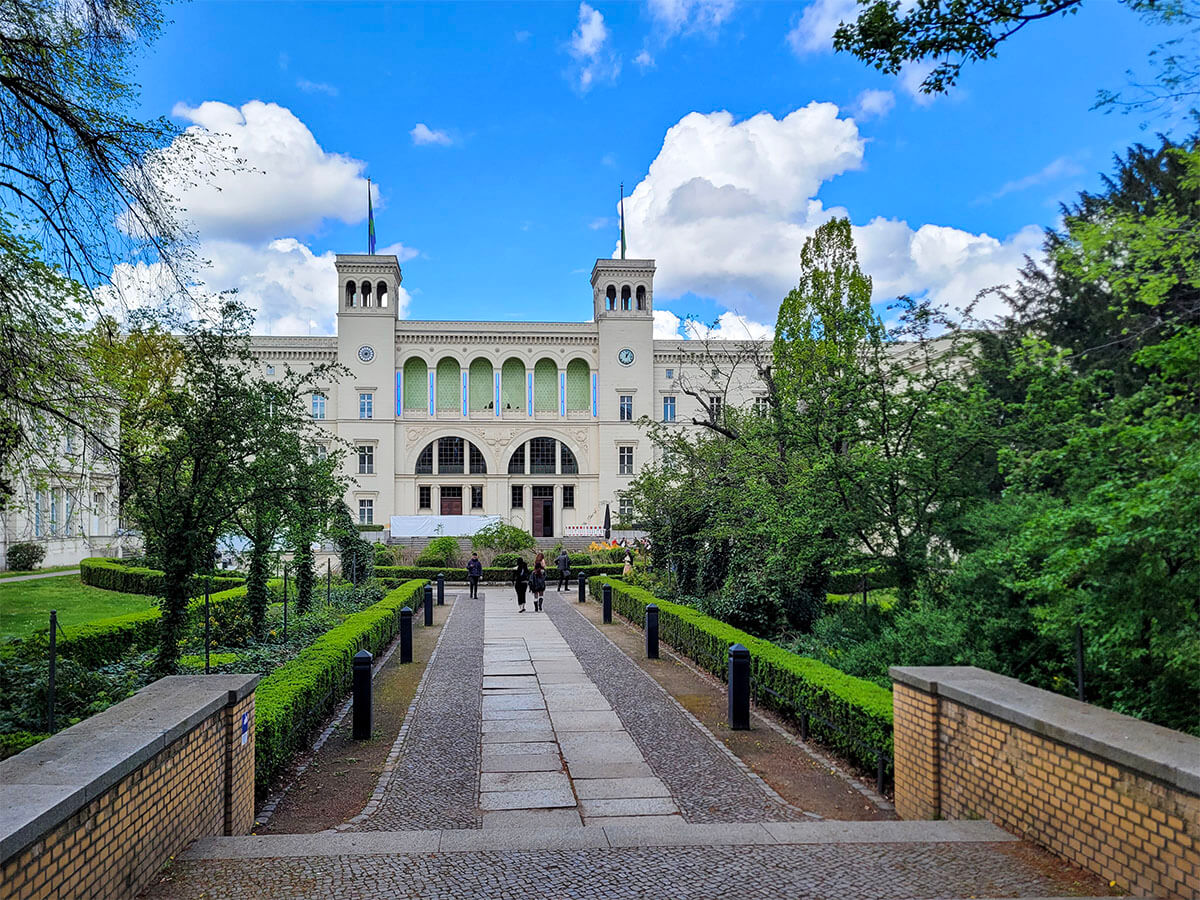



Fotografiska Berlin
Our next stop on our final day in Berlin was Fotografiska Berlin. This contemporary photography gallery is located in one of Berlin’s most famous former squats. The building has heritage status, so you can still see a lot of the original urban art from the 90s and 2000s.
The building is wheelchair accessible throughout with accessible toilets. Reduced ticket prices are available for disabled people, and companions and carers go free. Despite not having documentation to prove my disability, the staff member was happy to issue me a reduced ticket and grant Allan free admission, unlike Hamburger Bahnhof.
Fotografiska Berlin is located a little without the main touristy areas, so it may not be a place you come across easily. Some of the exhibition rooms were quite dark, so if that’s something you might find challenging, it’s worth considering.
Nonetheless, it is an interesting place to visit and explore the photography on display. However, I wouldn’t recommend it as a must-visit destination while you’re in Berlin.

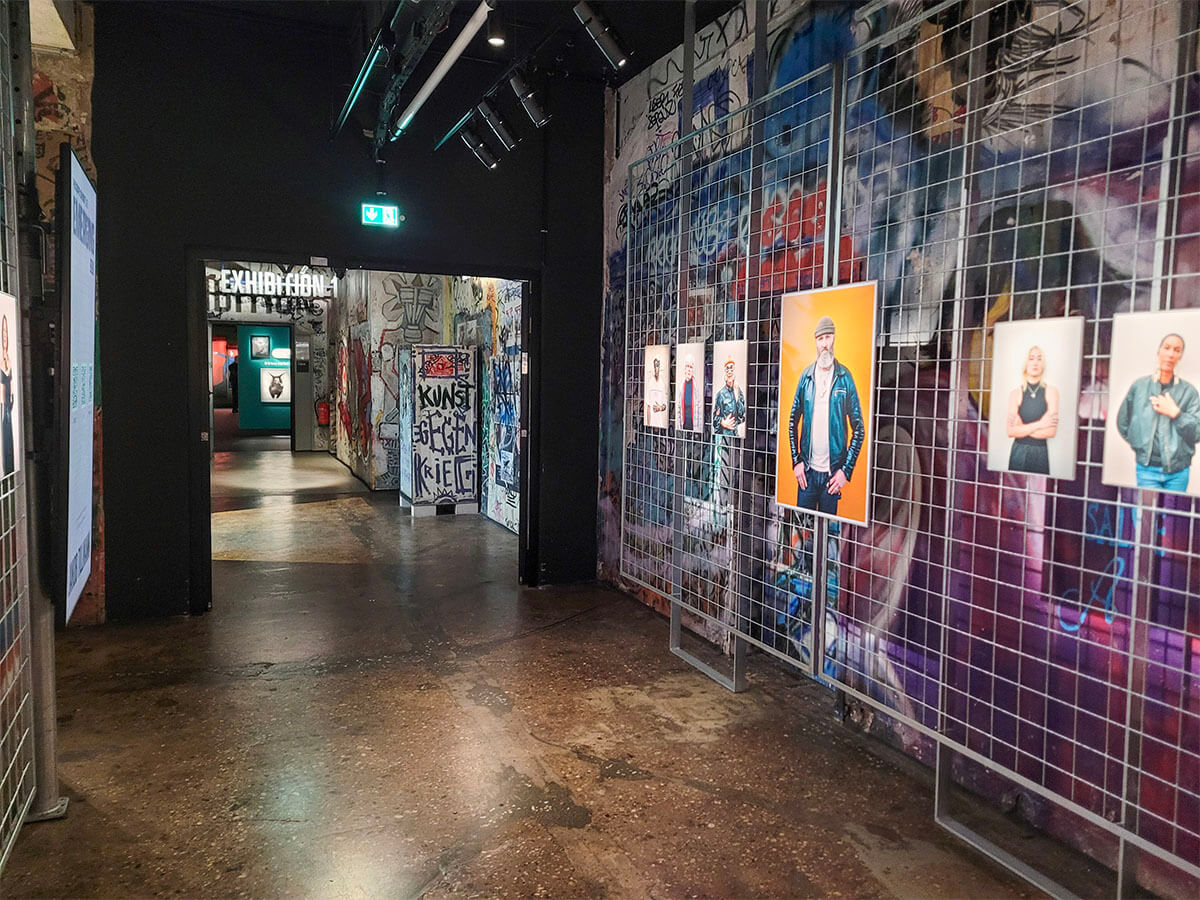


Your Wheelchair Accessible Trip to Berlin
I know this itinerary was quite lengthy, but hopefully it gave you some nuggets of information for planning your own wheelchair accessible trip to Berlin. Feel free to drop a comment below with any questions or thoughts you have!
I look forward to sharing more wheelchair accessible trips with you in future blog posts, so be sure to subscribe to join the Simply Emma community and be updated with new posts.
If you found this post or my other posts helpful and would like to support my work, please consider buying me a coffee. You can also follow me on social media at the links below.
Don’t miss a thing!
Keep up with my daily wheelchair accessible adventures in Scotland and beyond!
Follow me on Facebook | Instagram
Where Next: You Might Also Enjoy
The Circus Hotel, Berlin: Wheelchair Accessible Hotel Room Review
10 Wheelchair Accessible Things To Do In Amsterdam
4 Days in Barcelona Itinerary: The Ultimate Guide to Wheelchair Accessible Barcelona
3 Days In Amsterdam: A Wheelchair Users Travel Guide to Amsterdam
Pin ‘Accessibility in Berlin: A Wheelchair Accessible Travel Guide to Berlin’ and read later


Sharing is caring!





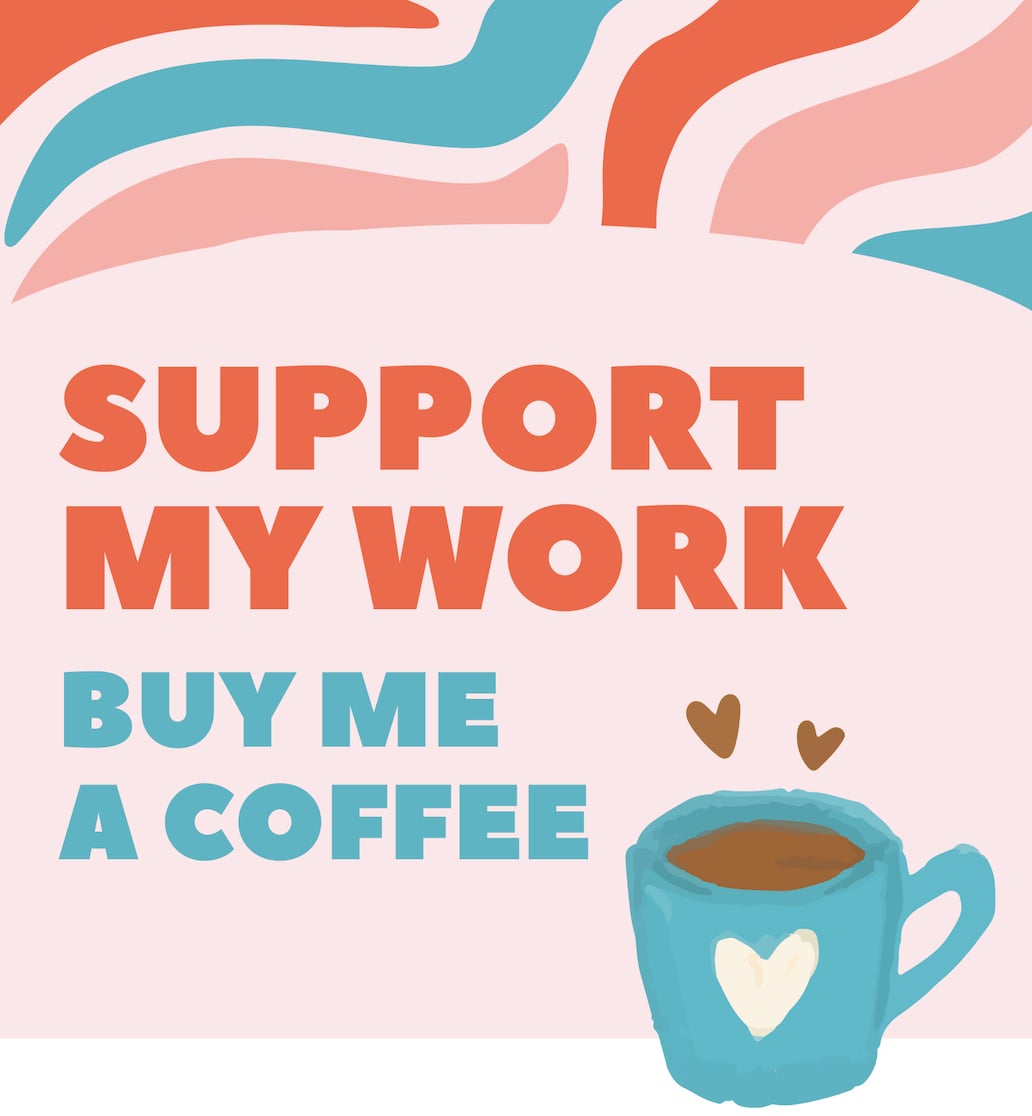

2 Responses
Hi Emma. My wife is a powered wheelchair user and I was wondering how you found getting to and from the airport and if you had any recommendations in this regard? Our hotel is next to tiergarten.
Hi Paul. Thanks for your comment. We actually got a taxi to and from the airport, and it worked very well for us. The hotel recommended and booked the taxi for us. The taxi company is called Space Cab – Luisenstadt Taxi GmbH, and their phone number is 030/694 10 90. I’d recommend asking your hotel to book it for you. However, I’m sure public transport would also be a good option for you. I tend to like travelling by taxi as it tends to be easier especially with luggage, etc. I’ll leave a hotel to my hotel review as I have a photo of the wheelchair accessible taxi I used. https://www.simplyemma.co.uk/the-circus-hotel-berlin-wheelchair-accessible-hotel-room-review/ Hope it helps 🙂 I hope you have a great time.